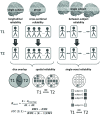Specificity, reliability and sensitivity of social brain responses during spontaneous mentalizing
- PMID: 27445211
- PMCID: PMC5091688
- DOI: 10.1093/scan/nsw098
Specificity, reliability and sensitivity of social brain responses during spontaneous mentalizing
Abstract
The debilitating effects of social dysfunction in many psychiatric disorders prompt the need for systems-level biomarkers of social abilities that can be applied in clinical populations and longitudinal studies. A promising neuroimaging approach is the animated shapes paradigm based on so-called Frith-Happé animations (FHAs) which trigger spontaneous mentalizing with minimal cognitive demands. Here, we presented FHAs during functional magnetic resonance imaging to 46 subjects and examined the specificity and sensitivity of the elicited social brain responses. Test-retest reliability was additionally assessed in 28 subjects within a two-week interval. Specific responses to spontaneous mentalizing were observed in key areas of the social brain with high sensitivity and independently from the variant low-level kinematics of the FHAs. Mentalizing-specific responses were well replicable on the group level, suggesting good-to-excellent cross-sectional reliability [intraclass correlation coefficients (ICCs): 0.40-0.99; dice overlap at Puncorr<0.001: 0.26-1.0]. Longitudinal reliability on the single-subject level was more heterogeneous (ICCs of 0.40-0.79; dice overlap at Puncorr<0.001: 0.05-0.43). Posterior temporal sulcus activation was most reliable, including a robust differentiation between subjects across sessions (72% of voxels with ICC>0.40). These findings encourage the use of FHAs in neuroimaging research across developmental stages and psychiatric conditions, including the identification of biomarkers and pharmacological interventions.
Keywords: animated shapes; biomarker; fMRI; reliability; spontaneous mentalizing.
© The Author (2016). Published by Oxford University Press. For Permissions, please email: journals.permissions@oup.com.
Figures




Similar articles
-
Differential responses of the dorsomedial prefrontal cortex and right posterior superior temporal sulcus to spontaneous mentalizing.Hum Brain Mapp. 2017 Aug;38(8):3791-3803. doi: 10.1002/hbm.23626. Epub 2017 May 27. Hum Brain Mapp. 2017. PMID: 28556306 Free PMC article.
-
Test-retest reliability of evoked BOLD signals from a cognitive-emotive fMRI test battery.Neuroimage. 2012 Apr 15;60(3):1746-58. doi: 10.1016/j.neuroimage.2012.01.129. Epub 2012 Feb 8. Neuroimage. 2012. PMID: 22330316
-
Short- and long-term reliability of language fMRI.Neuroimage. 2018 Aug 1;176:215-225. doi: 10.1016/j.neuroimage.2018.04.050. Epub 2018 Apr 25. Neuroimage. 2018. PMID: 29704615
-
Test-retest reliability of longitudinal task-based fMRI: Implications for developmental studies.Dev Cogn Neurosci. 2018 Oct;33:17-26. doi: 10.1016/j.dcn.2017.07.001. Epub 2017 Jul 13. Dev Cogn Neurosci. 2018. PMID: 29158072 Free PMC article. Review.
-
An integrative neural model of social perception, action observation, and theory of mind.Neurosci Biobehav Rev. 2015 Apr;51:263-75. doi: 10.1016/j.neubiorev.2015.01.020. Epub 2015 Feb 3. Neurosci Biobehav Rev. 2015. PMID: 25660957 Free PMC article. Review.
Cited by
-
Consensus Paper: Cerebellum and Social Cognition.Cerebellum. 2020 Dec;19(6):833-868. doi: 10.1007/s12311-020-01155-1. Cerebellum. 2020. PMID: 32632709 Free PMC article. Review.
-
Reduced tendency to attribute mental states to abstract shapes in behavioral variant frontotemporal dementia links with cerebellar structural integrity.Neuroimage Clin. 2019;22:101770. doi: 10.1016/j.nicl.2019.101770. Epub 2019 Mar 12. Neuroimage Clin. 2019. PMID: 30884367 Free PMC article.
-
Unveiling the neural dynamics of the theory of mind: a fMRI study on belief processing phases.Soc Cogn Affect Neurosci. 2024 Dec 23;19(1):nsae095. doi: 10.1093/scan/nsae095. Soc Cogn Affect Neurosci. 2024. PMID: 39659259 Free PMC article.
-
Social brain activation during mentalizing in a large autism cohort: the Longitudinal European Autism Project.Mol Autism. 2020 Feb 22;11(1):17. doi: 10.1186/s13229-020-0317-x. Mol Autism. 2020. PMID: 32087753 Free PMC article.
-
COMMON AND DISTINCT NEURAL CORRELATES OF SOCIAL INTERACTION PERCEPTION AND THEORY OF MIND.bioRxiv [Preprint]. 2025 Jun 4:2024.12.19.628993. doi: 10.1101/2024.12.19.628993. bioRxiv. 2025. PMID: 39763925 Free PMC article. Preprint.
References
-
- Abell F., Happé F., Frith U. (2000). Do triangles play tricks? Attribution of mental states to animated shapes in normal and abnormal development. Cognitive Development, 15, 1–16.
-
- Allison T., Puce A., McCarthy G. (2000). Social perception from visual cues: role of the STS region. Trends in Cognitive Sciences, 4(7), 267–78. - PubMed
-
- Apperly I.A., Butterfill S.A. (2009). Do humans have two systems to track beliefs and belief-like states? Psychological Review, 116(4), 953–70. - PubMed
-
- Bennett C.M., Miller M.B. (2010). How reliable are the results from functional magnetic resonance imaging? Annals of the New York Academy of Sciences, 1191, 133–55. - PubMed
MeSH terms
LinkOut - more resources
Full Text Sources
Other Literature Sources
Medical

